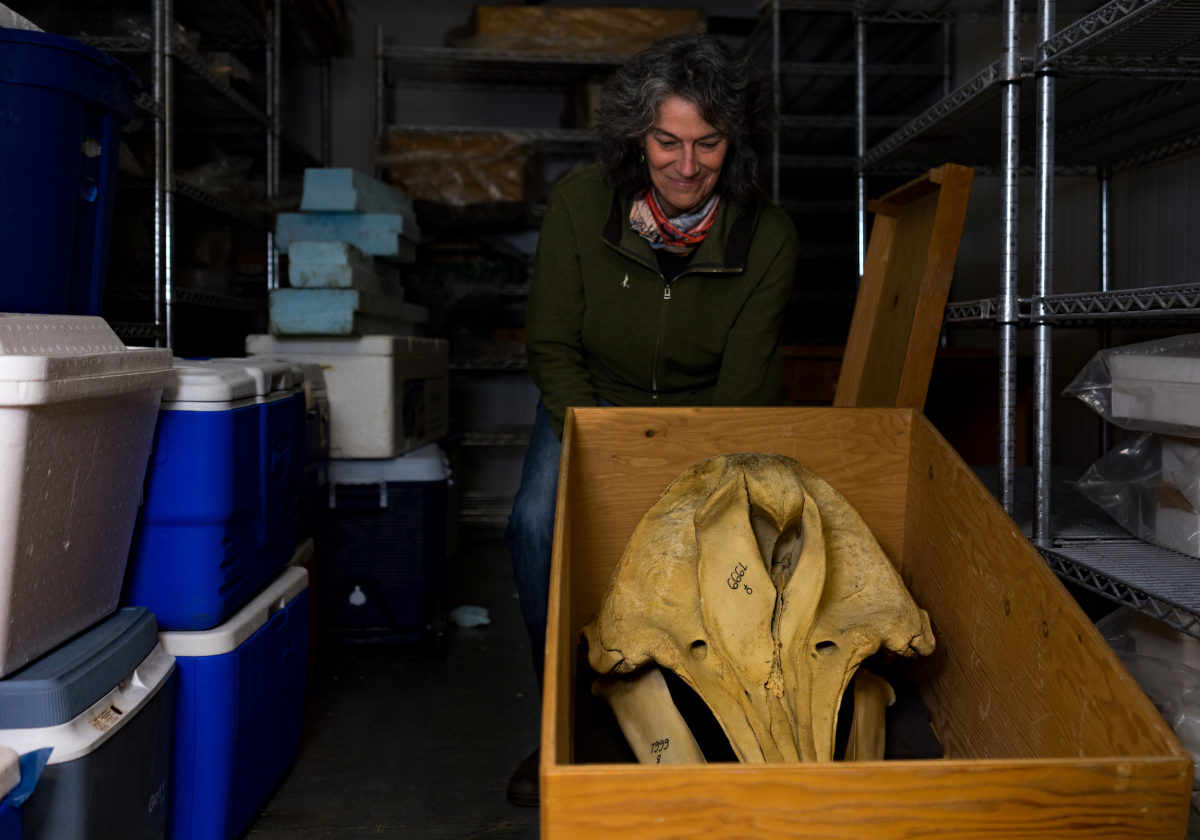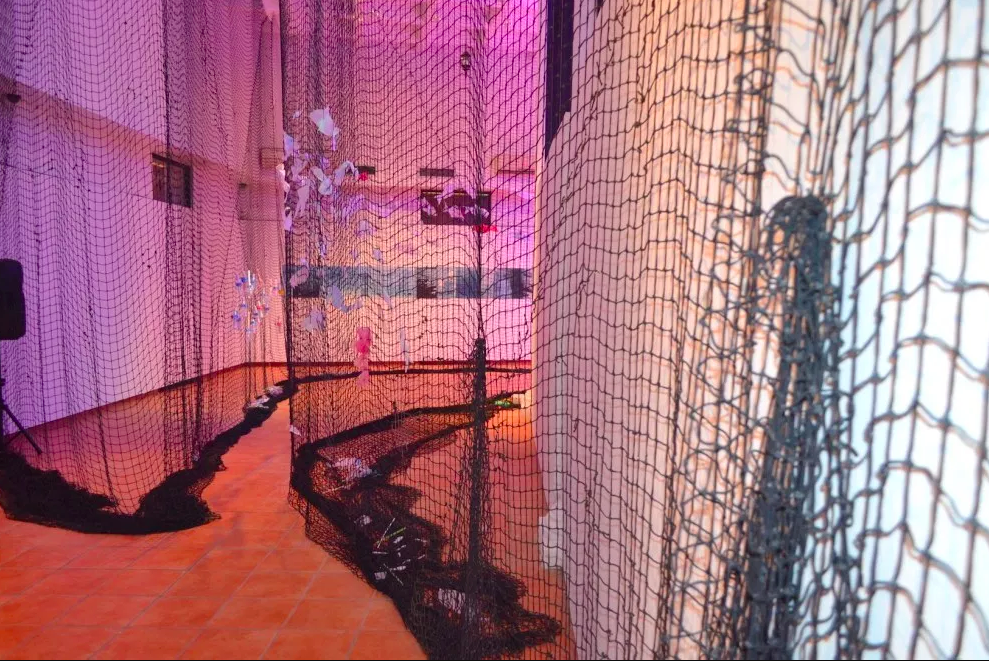Support strong Canadian climate journalism for 2025
In the UBC Beaty Biodiversity Museum, Vancouver's only natural history museum, an artist works on creating a styrofoam replica of a whale skeleton. It's an intriguing project by Yukon artist Joyce Majiski that highlights the intrusion of ocean pollution destroying whale habitat.
Introduced to Joyce by a mutual friend, I hit up UBC’s Beaty Biodiversity Museum, Vancouver's only natural history museum, and descend into its bowels. Joyce describes the early stages of her latest project: Song of the Whale—a project exploring natures’ perspective rather than my human-centric one, dialogue between whale and human.”
In a three-week “practice run” at the Beaty Museum, Joyce—her goal to replicate the vertebrae of a humpback whale—is experimenting, using the still-oily vertebrae of a beaked whale who died over sixty years ago, with different kinds of styrofoam; testing ways of gluing the odd-shaped bits together.
“It’s trial and error,” she says. “Take this hard chunk of discarded blue insulation foam, for instance. Good enough for outhouse seats, but too stiff to sculpt into the tiny, puzzle-like pieces needed to shape a vertebra.
“I’ve been searching far and wide to find the best materials possible. I not only lucked out on a more pliable styrofoam, I settled on a combination of rice paper and water—the consistency of papier-mâché—as the glue.
Once the vertebrae are done, she plans to drape the skin she's making, using ironed and sewn recycled plastic used polybags—over the skeleton.
"I may have to bulk the skeleton out a bit so it drapes properly,” she says.

With the help of Beaty biologist Chris Stinson, Joyce has already lined up the skeleton of a juvenile female humpback.
Why a humpback whale?
“I’m fascinated by their migratory habits," Majiski says. "The same humpbacks that feed all summer off Alaskan waters migrate thousands of kilometres to Hawaii to have their young. With every aspect of nature in constant flux, the humpback are a metaphor to remind us of global relatedness, an iconic reminder of the need for healthy oceans unhindered by human interference. The oceans circulate around the globe, touching all continents, reminding us we are all connected on this planet.
She's excited about the idea of basing the sculpture on a real humpback skeleton.
“The skeleton is lying in boxes in a shed on Salt Spring Island,” Joyce says, her eyes sparkling with excitement.
“My months-long dream has come true: just last week I received permission to use the bones. I'm currently searching for a place - or combination of places - to live and work on the Island to work.”

In the meantime, Joyce will keep gathering the supplies needed for her work. The Ocean Legacy Foundation, a B.C. non profit, has offered its support. Joyce will check out the materials collected on beach clean ups with a view to using certain of them in her installation.
The finished product—30-feet long—will be hung at the Yukon Arts Centre in Whitehorse for three months, the exhibition opening December 2020. The full sized humpback whale will be hung from the ceiling. Images will be projected on to the skin, the reflected light creating an atmosphere of being underwater. An accompanying soundscape will explore a conversation between humanity and whales.
“We will incorporate whale song and tanker traffic sound,” Joyce says, “a mix of natural and manufactured, experimental sound. A conversation between humanity and whale."
Aligned with its body low and tail arching up, viewers will have the opportunity to walk inside this underwater world and into the belly of the whale. Drinking dispensers filled with seawater full of micro plastics from the garbage patch in the Northern gyre will sit backlit against one of the walls. People will look around and wonder: is it plastic or is it jellyfish?
“I want to make the point that we have lost sight of the need to reduce our consumption. The styrofoam and plastic speak to our throw-away society, the critical need to divert materials from the landfill.”
Joyce's exhibition is a timely one. In recent years, whales have been washing up dead on beaches with stomachs full of plastic. In April, a pregnant whale was found in Italy with nearly 50 lbs of plastic waste in her stomach. Both the mother whale and her fetus were dead by the time people had found her.
And after the Whitehorse exhibition? Joyce is on the search for other venues. With any luck, the Vancouver Aquarium.
A good flow of creation
For Joyce, it’s all about viewing the environment from the perspective of the animals inhabiting it.
In 2007, Whitehorse hosted the Canada Winter Games. In 2004, Joyce received one of the artist one per cent for art commissions.
"I cut out and etched 30 copper birds,” she says, “each 3 feet x 8 feet, hammered them by hand and suspended them from the ceiling. I called the installation Winging North. There is an accompanying soundscape. The birds are installed in a space that is 100’ long x 24‘ wide and two stories high. So they can be seen from below and the side on the second floor.

“I was sad to see them leave the studio in the end, yet grateful at the same time. Winging North is the reason I was able to build a big studio—I call it ‘Tuktu,’ Inuit for Caribou—in the country. Since then, it’s been the site of many collaborative art projects.”
Sighing at the dearth of adequate funding for the arts, Joyce describes artists’ lives as “a complex weaving of opportunity and strategy.”
Despite the brief spell of stress regarding the monetary challenges, Joyce responds quickly when asked to tell me her idea of perfect happiness.
“That’s easy. It’s when I am in a good flow of creation! Endless amounts of time to wander aimlessly in nature, trolling beaches, collecting stones and beach glass, climbing hills and walking ridge-lines.”
Which living person does she most admire? “The ones who are walking their own paths.” The quality she most likes in a person? “Self awareness.”
If you were to die and come back as a person or a thing, what would it be?
“A gyrfalcon—these iconic and rarely seen birds of prey live in the far north. They are beautiful creatures, totally adapted to their environment.”
Beautiful art out of garbage
A key progenitor for Song of the Whale is Catch of the Day, a 2018 installation in Mazatlan, Mexico. Suspended from a 45 metre x 10 metre fishing net were fish made of ironed plastic bags and interwoven styrofoam. Also suspended were letters rolled into plastic water bottles—letters signed by mythical Sea Goddesses and sent from Ocean Management to humanity.
“I used plastic and garbage,” Joyce says, “As a way of examining the global connectivity that exist through the natural cycles of air and ocean currents and how they are influenced by humans through our consumption habits, geo-political migrations, and current changes in climate among other factors.

The deeper I delve into Joyce Majiski’s oeuvre, the more staggered I am—first, by its sheer volume. Though I asked for examples, never could I have imagined the residencies, circumpolar projects, collaborations, mentorships, etc. Even one of her swan paintings being turned into a rug design for the Yukon Room in the Canadian Embassy, Canada House in London.

“My design was complex,” Joyce says. “They had to use 30 shades of blue—mixing threads of different shades together. I eventually got to the UK and had a tour. The carpet looks amazing!”
“Initially, I was depressed with the knowledge gained by all of the research I was doing about water. It overwhelmed me. But as an artist, I can only do what I can do—bring people together in a non-oppositional way. I am driven to make beautiful things, even out of garbage."



Comments